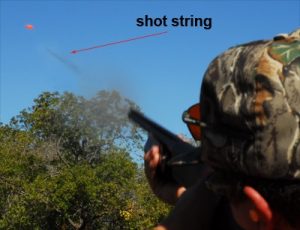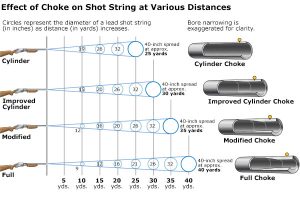A Brief Explanation of Shot Strings
Shot strings refer to the formation and spread of the pellets after they are fired from the shotgun. When a shotgun is fired, multiple pellets are propelled in a cluster, with the formation and spacing of these pellets forming the shot string. The concept of shot string is crucial in shotgun shooting as it influences the shooting pattern and the subsequent damage on the target.
The length and spread of the shot string can depend on several factors. These include the type of shotgun used, the kind of ammunition, and the barrel choke. Moreover, external factors such as wind speed and direction, the distance to the target, and even the shooter’s technique can drastically affect the shot string. Therefore, understanding these variables is key for any shooter looking to enhance their shotgun performance.

The shot string can be categorized into two types: short and long shot strings. Short shot strings contain fewer pellets, but they travel at faster speeds. On the contrary, long shot strings have more pellets, but they travel at slower speeds. Each of these shot strings has its pros and cons, with the choice depending on the shooter’s preference and the shooting situation.
The Science Behind the Formation of Shot Strings
The formation of shot strings is a product of physics and engineering. When a shotgun shell is fired, the ignition of the powder creates high-pressure gases that propel the shot or pellets out of the barrel. As the shot travels through the air, it encounters air resistance, which starts to slow down the pellets, causing them to spread apart and form the shot string.
The velocity of the pellets and their size and shape also account for the shot string’s formation. Smaller and lighter pellets will slow down faster due to air resistance, causing the shot string to become longer. On the other hand, larger and heavier pellets maintain their velocity for longer, resulting in a shorter shot string.
Furthermore, the barrel choke can also influence the shot string. A tight choke constrains the shot more, leading to a longer, more concentrated shot string. Conversely, a more open choke allows the shot to spread more quickly, resulting in a shorter, wider shot string.

Implications of Shot Strings on Shotgun Performance
Understanding the concept of shot strings is crucial for maximizing shotgun performance. A longer shot string can offer a larger hitting area, increasing the chance of hitting a moving target. However, this could also mean a less concentrated impact, which might not be ideal for certain types of game or targets.
On the other hand, a shorter shot string delivers a more concentrated and powerful impact on the target, making it more suitable for larger game or stationary targets. However, the smaller hitting area means that it requires greater precision and skill from the shooter.
In essence, knowing how to manipulate the shot string according to the situation can give a shooter the edge. For instance, a shooter may choose a longer shot string when hunting small, fast-moving game, while a shorter shot string may be employed when hunting larger, slower game.
The Art of Mastering Shotgun Shell Shot Strings
Mastering the art of shot strings is not just about understanding the science behind it, but it’s also about the practice. Experimenting with different shot sizes, shells, and chokes, in different conditions, can help shooters understand how these variables affect the shot string.
Recording observations and results during practice can be a useful method for mastering shot strings. By noting down the effects of different variables on the shot string, shooters can develop a better understanding of what works best for their shooting style and the specific target or game.
# # #


Comments